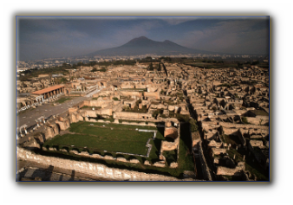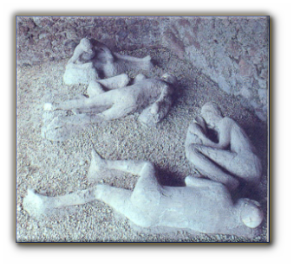To Pompei - PlanetServiceRome
Main menu:
To Pompei
Pompei was an Opician foundation of the 6th century BC, and Dionysus of Halicarnassus maintained that Herculaneum (Ercolano) was founded by Hercules on his way back to Greece from Spain. Both underwent several changes of overlord in the centuries that followed -
Excavations have revealed the development of Pompei in particular. The original settlement, to the south-
After Pompei became part of the Roman territory, it was further endowed with fine public buildings in stone, such as the large amphitheatre, the forum baths, and the odeon (small theatre) alongside the theatre. There was an episode of modernization at the end of the 1st century BC, with the construction of an aqueduct to bring the waters of the Samo River to the town, where they were distributed by means of a sophisticated supply system to houses, baths, and public fountains. High sidewalks were built along the streets, with stepping stones to facilitate crossing.
Herculaneum was a much smaller town (320m by 370m within its walls) on the coast. The latest layout, on the standard classical "Hippodamian" grid, dates from the end of the 1st century BC. The wide main street (decumanus maximus) also served as the forum, and was lined with public buildings, such as a basilica, a shrine to Hercules, a theatre, and public baths. The houses in the centre of the town were spacious, with panoramic views on the sea, which at that time came up right up to the town. There was a sacred area, with shrines and baths, outside the walls, and the surroundings contained many fine villas, such as the magnificent Villa of the Papyri.
The roles of the two towns were very different. Pompei was a commercial town, benefiting from river trade along the Samo between the interior and the coast and from that along the coastal road between Cumae and southern Campania. It was also the centre of an important wine-
The lives of both towns came to an abrupt and catastrophic end on 24 August in AD 79. The area had been shaken by an earthquake shortly before and reconstruction work was still in progress when Vesuvius erupted with tremendous violence. Pompei was buried under a thick layer of volcanic ash and stone and Herculaneum disappeared under a pyroclastic flow of many metres of volcanic mud.



Mercedes S Class 1/2 People (POMPEI)
Mini-Van 3/4 People (POMPEI)
Mini-Van 4/5 People (POMPEI)
Multi-Van 5/6 People (POMPEI)
Multi-Van 6/7 People (POMPEI)
Multi-Van 7/8 People (POMPEI)
Sedan 1/2 People (POMPEI)
Sedan 2/3 People (POMPEI)

Please remember to specify in the notes field of the booking form,
the days when you want the tour.
dstfhghgdffddgfffgfgdhfghggfhghggfgfgfdgfghgfdf gggffgf dgg
Information of Pompei Tour:
TOUR -
This daytrip excursion is for those who wish to enjoy the archaeological site of Pompei.
SHARE THIS TOUR:
You can share this cruise excursions with friends and cruisers you've met on board and SAVE a great deal!
Why take a Ship Coach tour when you can ride in the comfort of your own private Luxury van for up to 8 cruisers
and your own personal English speaking driving guide that will drive you to the Major Highlights with very little walking?
Very simple to do, be the first to place an ad on the Cruise Critic roll call and have others join you.
Lot's of fun, split the costs and SAVE!
Take advantage of our special discount rates for booking multiple tours, you can see our discounted rates above and shared tours are also eligible!
PAYMENTS:
Payments only in cash with Euro currency directly to your driver or at time of reservation with Paypal.
Our rates do not include private guides, entrance fees or meals unless mentioned in our confirmation.
* Tips are not included in our rates but if you were serviced well and are happy with your driver a 10% minimum tip is customary.
Our driver will go at your pace and will allow all the time you need to visit the sites with NO RUSHING as in group tours. By Italian law he is unable to conduct guiding inside museums, monuments, etc.
Please note:
Our rate INCLUDES a personal Luxury Vehicle and English speaking driver and a personal English speaking Tour Guide for the entire duration of the tour.
Our rates DO NOT INCLUDE entrance fees to sites, meals, ferry or hydrofoil rides and whatever is not mentioned as included.
